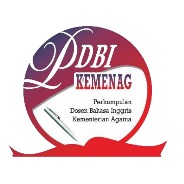How Mr. Bean Film Influence Student’s Engagement in Learning Tenses
Abstract
Keywords
Full Text:
PDFReferences
Adhikari, Y. N. (2021). Integrating technology into English language teaching in Nepal: Student and teacher perspectives. Prithvi Academic Journal, 4, 107-120.
Afshari, M., Abu Bakar, K., & Su Luan, W. (2009). Factors affecting teachers’ use of information and communication technology. International Journal of instruction, 2(10), 77−98.
Ahmadi, D. M. R. (2018). The use of technology in English language learning: A literature review [Research]. International Journal of Research in English Education, 3(2), 115-125. https://doi.org/10.29252/ijree.3.2.115
Al-Awidi, H., & Aldhafeeri, F. (2017). Teachers’ readiness to implement digital curriculum in Kuwaiti schools. Journal of Information Technology Education: Research, 16, 105−126. https://doi.org/10.28945/3685.
Albahlal, F. S. (2019). The impact of YouTube on improving secondary school students’ speaking skills: English language teachers’ perspectives. Journal of Applied Linguistics and Language Research, 6(2), 1-17.
Alghasab, M. B., Alfadley, A., & Aladwani, A. M. (2020). Factors affecting technology integration in EFL classrooms: The Case of Kuwaiti Government Primary Schools. Journal of Education and Learning, 9(4), 10-27.
Aliyev, A. (2017). Improving English writing skills of non-native undergraduate learners with the help of movies supported by online technologies. Journal of Education in Black Sea Region, 2(2).
Al-Kafyulilo, A., Fisser., P., & Voogt, J., (2015). Factors affecting teachers’ continuation of technology use in teaching. Educ Inf Technol, 21, 1535–1554. https://doi.org/10.1007/s10639-015-9398-0
Alkhudaydi, M. D. (2018). Investigating factors that influence the use of YouTube in teaching Biology in high schools in Saudi Arabia based on the technology acceptance model. International Interdisciplinary Journal of Education, 7(11).
Alluri, P. (2018). Enhancing English Language Teaching through Films in General Foundation Programs. [Paper Presentation]. In Arab World English Journal (AWEJ) Proceedings. 1st MEC TESOL Conference.
Almalki, A. (2020). Integration of Technology among Saudi EFL Teachers. English Language Teaching, 13(8), 160-167.
Almurashi, W. A. (2016). The effective use of YouTube videos for teaching English language in classrooms as supplementary material at Taibah University in Alula. International Journal of English Language and Linguistics Research, 4(3), 32-47.
Apriani, E. (2016). A New Literacy: The role of technology to develop students' character. Ta'dib: Journal of Islamic Education (Jurnal Pendidikan Islam), 21(1), 59-72.
Apriani, E., & Hidayah, J. (2019). The ICT Used by the English Lecturers for Non-English Study Program Students at IAIN Curup. Vision: Journal for Language and Foreign Language Learning, 8(1), 26-37.
Apriani, E., Inderawati, R., Arianti, A., Wati, S., & Hakim, I. N. (2021). Implementing E-learning training toward English Virtual Lecturers: The Process, Perspectives, Challenges and Solutions. International Journal of Emerging Technologies in Learning, 16(4).
Apriani, E., Supardan, D., & Umami, M. (2020, November). Independent Learning: English Teachers Problems in Designing a Good Lesson Plan in New Normal Era at MAN Rejang Lebong. In International Conference on the Teaching English and Literature, 1(1), 72-78.
Apriani, E., Supardan, D., Sartika, E., Suparjo, S., & Hakim, I. N. (2019). Utilizing ict to develop students language ethic at islamic university. Potensia: Jurnal Kependidikan Islam, 5(1), 1-14.
Arianti, A. (2019). The Usage Of Youtube Video In Teaching English For Young Learner (Teyl) For Sixth Semester Students of English DepartmenT. Cordova Journal: languages and culture studies, 9(1), 1-16.
Borthwick, K., & Gallagher A. (2014). ‘Inspiration, ideas, encouragement’: Teacher development and improved use of technology in language teaching through open educational practice. Computer Assisted Language Learning, 27(2), 163-183. https://doi.org/10.1080/09588221.2013.818560
Bouzenoun, A. (2018). The Constraints that Influence the Application of Feature Films in EFL Classrooms in Algeria. Journal of Second Language Teaching & Research, 6(2), 5-26.
Çebi, A. (2018). Teachers’ Perceptions Toward Technology Integration into the Language Teaching Practices. Journal of Narrative and Language Studies, 6(11), 150-177. https://doi.org/10.1080/09588221.2012.654495
Chaaban, Y., & Ellili-Cherif, M. (2017). Technology integration in EFL classrooms: A study of Qatari independent schools. Education and Information Technologies, 22(5), 2433-2454.
Deng, L., & Yuen, A. H. (2011). Towards a framework for educational affordances of blogs. Computers & education, 56(2), 441-451.
DeWitt, D., Alias, N., Siraj, S., Yaakub, M. Y., Ayob, J., & Ishak, R. (2013). The potential of YouTube for teaching and learning in the performing arts [Paper Presentation]. Procedia - Social and Behavioral Sciences, 103, 1118–1126. https://doi.org/10.1016/j.sbspro.2013.10.439
Dörnyei, Z. (2007). Research methods in applied linguistics: Quantitative, qualitative, and mixed methodologies. Oxford: Oxford University Press.
Eickelmann, B. (2011). Supportive and hindering factors to a sustainable implementation of ICT in schools. Journal of Educational Research Online, 3(1), 75–103.
Fathurrochman, I., & Apriani, E. (2017). Pendidikan Karakter Prespektif Pendidikan Islam dalam Upaya Deradikalisasi Paham Radikal. Potensia: Jurnal Kependidikan Islam, 3(1), 122.
Goctu, R. (2017). Using movies in EFL classrooms. European Journal of Language and Literature, 3(2), 121-124.
Goldstein, B., & Driver, P. (2014). Language learning with digital video. Cambridge University Press
Guan, N., Song, J., & Li, D. (2018). On the advantages of computer multimedia-aided english teaching [Paper Presentation]. Procedia Computer Science, 131, 727–732. https://doi.org/10.1016/j.procs.2018.04.317.
Gudea, S. (2010). Expectation and Demand in Online Teaching, Practical Experience. Information Science Publishing: New York.
Hakim, B. (2020). Technology Integrated Online Classrooms and the Challenges Faced by the EFL Teachers in Saudi Arabia during the COVID-19 Pandemic. International Journal of Applied Linguistics and English Literature, 9(5), 33-39.
Halic, O., Lee, D., Paulus, T., & Spence, M. (2010). To blog or not to blog: Student perceptions of blog effectiveness for learning in a college-level course. The Internet and higher education, 13(4), 206-213.
Hameed, P. F. M. (2016). Short films in the EFL classroom: Creating resources for teachers and learners. International Journal of Applied Linguistics and English Literature, 5(2), 215-219.
Hariyono, T. C. (2020). Teaching vocabulary to young learner using video on youtube at english course. Language Research Society, 1(1).
Harvey, G., & Hurworth, R. (2006). Exploring program sustainability: Identifying factors in two educational initiatives in Victoria. Evaluation Journal of Australasia, 6(1), 36–44. https://doi.org/10.1177/1035719X0600600106
Huang, H. W., Wu, C. W., & Chen, N. S. (2012). The effectiveness of using procedural scaffoldings in a paper-plus-smartphone collaborative learning context. Computers & Education, 59(2), 250-259.
Kendiani, S. D. (2020). The Islamic Characters in Teaching English. Journal of English Education and Teaching, 4(3), 431-448.
Khatoony, S., & Nezhadmehr, M. (2020). EFL teachers' challenges in integration of technology for online classrooms during Coronavirus (COVID-19) pandemic in Iran. AJELP: Asian Journal of English Language and Pedagogy, 8(2), 89-104.
Kühl, T., Scheiter, K., Gerjets, P., & Gemballa, S. (2011). Can differences in learning strategies explain the benefits of learning from static and dynamic visualizations?. Computers & Education, 56(1), 176-187.
Lam, Y. (2000). Technophilia vs. technophobia. A preliminary look at why second language teachers do or do not use technology in their classrooms. Canadian Modern Language Review, 56, 389–420. https://doi.org/10.3138/cmlr.56.3.389
Li, L., & Walsh, S. (2010). Technology uptake in Chinese EFL classes. Language Teaching Research, 15(1), 99– 125. https://doi.org/10.1177/1362168810383347
Mahdi, H. S., & Al-Dera, A. S. A. (2013). The Impact of Teachers' Age, Gender and Experience on the Use of Information and Communication Technology in EFL Teaching. English Language Teaching, 6(6), 57-67. https://doi.org/10.5539/elt.v6n6p57
Mackey, T. P., & Ho, J. (2008). Exploring the relationships between web usability and students’ perceived learning in web-based multimedia (WBMM) tutorials. Computers & Education, 50(1), 386-409.
Meilinda, S., Noviyenty, L., & Apriani, E. (2021). The Learning Strategies in English Subject of Islamic Study Program at Iain Curup. International Journal of Education Research and Development, 1(1), 78-102.
Miller, E. (2016). Can you learn a new language by watching movies?. http://www.strategiesinlanguagelearning.com/learn-new-language-by-watching- movies/
Moghavvemi, S., Sulaiman, A., Jaafar, N. I., & Kasem, N. (2018). Social media as a complementary learning tool for teaching and learning: The case of youtube. The International Journal of Management Education, 16(1), 37-42.
Mohamad, A. (2021). The Novel Adaptation Film as a Teaching Language and Literature Media. Turkish Journal of Computer and Mathematics Education (TURCOMAT), 12(3), 1138-1146.
Otchie, W. O., Pedaste, M., Bardone, E., & Chounta, I. A. (2020). Can YouTube videos facilitate teaching and learning of STEM subjects in high schools?. Bulletin of the Technical Committee on Learning Technology (ISSN: 2306-0212), 20(1), 3-8.
Pallant, J. (2013). SPSS survival manual. McGraw-Hill Education (UK).
Patil, D. P. (2020). Trends and Challenges in English Language Teaching. Studies in Indian Place Names, 40(39), 158-164.
Petta, J. R., Johnson, A. C., Taylor, J. M., Laird, E. A., Yacoby, A., Lukin, M. D., & Gossard, A. C. (2005). Coherent manipulation of coupled electron spins in semiconductor quantum dots. Science, 309(5744), 2180-2184.
Roza, V. (2021). Incorporating both Zoom and YouTube in Micro Teaching Class during the Covid-19 Pandemic: An Effectiveness Investigation. In Journal of Physics: Conference Series 1779(1), 12033.
Saqlain, N., & Mahmood, Z. (2013). English Language Instructors' Perceptions about Technology-Based Language Learning at Northern Border University in Saudi Arabia. Turkish Online Journal of Educational Technology-TOJET, 12(2), 106-110
Selvi, O., Tulgar, S., Senturk, O., Topcu, D. I., & Ozer, Z. (2019). YouTube as an informational source for brachial plexus blocks: evaluation of content and educational value. Brazilian Journal of Anesthesiology (English Edition), 69(2), 168–176. https://doi.org/10.1016/j.bjane.2018.12.005
Silviyanti, T. M. (2014). Looking into EFL students’ perceptions in listening by using English movie videos on YouTube. Studies in English Language and Education, 1(1), 42-58.
Sommer, P. (2001). Using film in the English classroom: Why and how.
Szeto, E., & Cheng, A. Y. N. (2014). Exploring the usage of ICT and YouTube for teaching: A study of pre-service teachers in Hong Kong. The Asia-Pacific Education Researcher, 23(1), 53-59.
Tweed, S. R. (2013). Technology implementation: Teacher age, experience, self-efficacy, and professional development as related to classroom technology integration.
Voller, P., & Widdows, S. (1993). Feature films as text: A framework for classroom use. ELT journal, 47(4), 342-353.
DOI: http://dx.doi.org/10.29240/ef.v7i2.8734
Refbacks
- There are currently no refbacks.
Copyright (c) 2023 Prodhan Mahbub Ibna Ibna Seraj, Ahmad Al Yakin, Ghada Tosson Abd Al-Lateef

This work is licensed under a Creative Commons Attribution-NonCommercial-ShareAlike 4.0 International License.
INDEXED BY:
 This work is licensed under a Creative Commons Attribution-NonCommercial-ShareAlike 4.0 International License
This work is licensed under a Creative Commons Attribution-NonCommercial-ShareAlike 4.0 International License
@ ENGLISH FRANCA : Academic Journal of English Language and Education
Jl. Dr. AK Gani No 1 Dusun Curup, Rejang Lebong Regency, Bengkulu Province, Indonesia, 39119.
Dr. Eka Apriani, M.Pd., email: efranca@iaincurup.ac.id, eka.apriani@iaincurup.ac.id.




.png)












